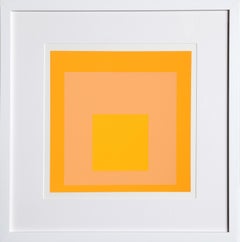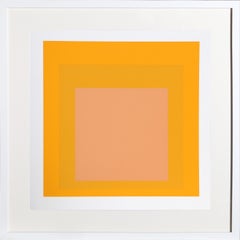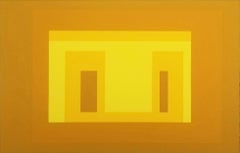Josef Albers Abstract Prints
No artist has contributed more to our understanding of color than German-born painter, writer and educator Josef Albers (1888–1976). At the Bauhaus, Albers taught what was perhaps the first course dedicated to the study of how different hues interact with one another.
“In order to use color effectively it is necessary to recognize that color deceives continually,” he wrote in The Interaction of Color, a compilation of his 30 years of research into color theory at the Bauhaus, Black Mountain College and Yale University School of Art, where he was head of the department of design.
Albers dismissed the notion that colors could be understood solely through their physical properties. Instead, he emphasized their unstable, seductive, character and the necessity of observing their behavior in different contexts. “If one says ‘red’ — the name of color — and there are fifty people listening, it can be expected that there will be fifty reds in their minds,” he wrote. “And one can be sure that all these reds will be very different.”
The wealth of prints, lithographs and other works by Albers are studies in color perception. The paintings of “Homage to the Square” — his most iconic series, begun in 1950 and stretching over more than 25 years — investigate the perceptual mutations produced when colors are juxtaposed in nested squares.
The simplicity of these compositions is deceptive, demonstrating as they do how the illusion of dimensionality and afterimages can be created using entirely flat forms. Albers painted nearly a thousand “homages,” and his treatment of color as a metamorphosing, magical element was crucial to the development of the Op art movement.
Browse a provocative collection of screenprints, lithographs and more by Josef Albers at 1stDibs.
1960s Abstract Geometric Josef Albers Abstract Prints
Pencil, Screen
1970s Abstract Geometric Josef Albers Abstract Prints
Screen
1970s Abstract Geometric Josef Albers Abstract Prints
Screen
1970s Abstract Geometric Josef Albers Abstract Prints
Screen
1970s Abstract Geometric Josef Albers Abstract Prints
Screen
1960s Abstract Geometric Josef Albers Abstract Prints
Screen
1970s Abstract Geometric Josef Albers Abstract Prints
Screen
1970s Abstract Geometric Josef Albers Abstract Prints
Screen
1970s Abstract Geometric Josef Albers Abstract Prints
Screen
1970s Abstract Geometric Josef Albers Abstract Prints
Screen
1970s Abstract Geometric Josef Albers Abstract Prints
Screen
1970s Minimalist Josef Albers Abstract Prints
Screen
1970s Abstract Geometric Josef Albers Abstract Prints
Screen
1970s Abstract Geometric Josef Albers Abstract Prints
Screen
1970s Abstract Geometric Josef Albers Abstract Prints
Screen
1970s Abstract Geometric Josef Albers Abstract Prints
Screen
1960s Abstract Geometric Josef Albers Abstract Prints
Screen
Late 20th Century Modern Josef Albers Abstract Prints
Board
1970s Abstract Geometric Josef Albers Abstract Prints
Screen
1970s Abstract Geometric Josef Albers Abstract Prints
Screen
1970s Abstract Geometric Josef Albers Abstract Prints
Screen
1960s Abstract Geometric Josef Albers Abstract Prints
Screen
1970s Abstract Geometric Josef Albers Abstract Prints
Screen
1970s Abstract Geometric Josef Albers Abstract Prints
Screen
1970s Abstract Geometric Josef Albers Abstract Prints
Screen
1960s Abstract Geometric Josef Albers Abstract Prints
Screen
1970s American Modern Josef Albers Abstract Prints
Screen
1970s Abstract Geometric Josef Albers Abstract Prints
Screen
1970s Abstract Geometric Josef Albers Abstract Prints
Screen
1960s Abstract Geometric Josef Albers Abstract Prints
Screen
1970s Abstract Geometric Josef Albers Abstract Prints
Screen
1970s Abstract Geometric Josef Albers Abstract Prints
Screen
1970s Abstract Geometric Josef Albers Abstract Prints
Screen
1970s Abstract Geometric Josef Albers Abstract Prints
Screen
1960s Abstract Josef Albers Abstract Prints
Screen
1970s Abstract Geometric Josef Albers Abstract Prints
Screen
1970s Abstract Geometric Josef Albers Abstract Prints
Screen
1970s Abstract Geometric Josef Albers Abstract Prints
Screen
1970s Abstract Geometric Josef Albers Abstract Prints
Screen
1970s Abstract Geometric Josef Albers Abstract Prints
Screen
1970s Minimalist Josef Albers Abstract Prints
Screen
1970s Abstract Geometric Josef Albers Abstract Prints
Screen
1970s Abstract Geometric Josef Albers Abstract Prints
Screen
1970s Abstract Geometric Josef Albers Abstract Prints
Screen
1970s Abstract Geometric Josef Albers Abstract Prints
Screen
1970s Abstract Geometric Josef Albers Abstract Prints
Screen
1970s Abstract Geometric Josef Albers Abstract Prints
Screen
1970s Abstract Geometric Josef Albers Abstract Prints
Screen
1970s Abstract Geometric Josef Albers Abstract Prints
Screen
1970s Abstract Geometric Josef Albers Abstract Prints
Screen
1970s Abstract Geometric Josef Albers Abstract Prints
Screen
1970s Minimalist Josef Albers Abstract Prints
Screen
1970s Abstract Geometric Josef Albers Abstract Prints
Screen
1960s Abstract Geometric Josef Albers Abstract Prints
Lithograph
1970s Abstract Geometric Josef Albers Abstract Prints
Screen
1970s Abstract Geometric Josef Albers Abstract Prints
Screen
1970s Abstract Geometric Josef Albers Abstract Prints
Screen
1960s Abstract Josef Albers Abstract Prints
Screen
1970s Abstract Geometric Josef Albers Abstract Prints
Screen
1970s Abstract Geometric Josef Albers Abstract Prints
Screen
Josef Albers abstract prints for sale on 1stDibs.
Artists Similar to Josef Albers
- Who is Josef Albers?1 Answer1stDibs ExpertMarch 22, 2022Josef Albers is an artist associated with the Bauhaus movement who lived from 1888 to 1976. He developed an important color theory hypothesis and employed it in works like his "Homage to the Square" series. On 1stDibs, find a selection of Josef Albers art.
- How did Josef Albers paint?1 Answer1stDibs ExpertMarch 22, 2022Josef Albers usually painted with a palette knife instead of a paintbrush, liking how the increased level of control allowed him to create sharp, well-defined lines. He rarely used a palette, normally applying paint right from the tube. Usually, he produced his pieces on Masonite board to add texture to the compositions. On 1stDibs, find a collection of Josef Albers art.
- How do I pronounce Josef Albers?1 Answer1stDibs ExpertMarch 22, 2022To pronounce Josef Albers, say "JOW-suf ALL-burz." His first name is the German spelling of the English name Joseph and said in much the same way. His last name is also of German origin. On 1stDibs, find a range of Josef Albers art.
- Where did Josef Albers teach?1 Answer1stDibs ExpertMarch 22, 2022Josef Albers taught at more than one school during the course of his life. After a brief period of time as an elementary school teacher in Bottrop, Germany, he enrolled in the Bauhaus school and began teaching classes there within a few years. After moving to the U.S., he taught at Black Mountain College in North Carolina and the Yale University School of Art in Connecticut. Shop a range of Josef Albers art on 1stDibs.
- Who were Josef Albers’ parents?1 Answer1stDibs ExpertMarch 22, 2022Josef Albers's parents were Magdalena and Lorenz Albers. His father worked as a handyman, painting houses, performing repairs and doing carpentry jobs, and his mother came from a long line of blacksmiths. You'll find a variety of Josef Albers art on 1stDibs.
- When was Josef Albers born?1 Answer1stDibs ExpertMarch 22, 2022Josef Albers was born on March 19, 1888, in Bottrop, Germany. He would go on to become a leader of the modern art movement and to make huge strides in the area of color theory research. Shop a selection of Josef Albers art on 1stDibs.
- What inspired Josef Albers?1 Answer1stDibs ExpertMarch 22, 2022What inspired Josef Albers changed over the course of his life. During the Bauhaus period, his colleagues Johannes Itten and László Moholy-Nagy greatly influenced his work. In the 1950s, Albers and his wife, textile artist Anni Albers, frequently traveled to Mexico to draw inspiration from the local architecture and art. On 1stDibs, shop a range of Josef Albers art.
- What is Josef Albers known for?1 Answer1stDibs ExpertMarch 22, 2022Josef Albers is known for his work as a painter, educator and writer. His work as an artist helped to define the modern period and advance color theory, changing the way future generations approached their own art. His "Homage to the Square" series contains his most famous pieces. On 1stDibs, find a variety of Josef Albers art.
- 1stDibs ExpertMarch 22, 2022Josef Albers came to America in 1933 after the Nazis shuttered the Bauhaus. He and his wife, the textile artist Anni Albers, originally settled in North Carolina. During his time there, Albers taught at Black Mountain College. Shop a variety of Josef Albers art on 1stDibs.
- 1stDibs ExpertMarch 22, 2022Josef Albers's color theory holds that the only way to fully understand a single color is to view it alongside other colors. He believed that surrounding colors had the ability to change the perception of a hue, and he used his "Homage to the Square" series to demonstrate this. Find a variety of Josef Albers art on 1stDibs.
- 1stDibs ExpertMarch 22, 2022Josef Albers taught many subjects at the Bauhaus. When he began as a teacher, he oversaw the Vorkurs, the introductory course that reviewed composition, construction, design, color theory and other fundamentals. In later years, he became a full professor and expanded his course offerings. On 1stDibs, shop a selection of Josef Albers art.
- 1stDibs ExpertMarch 22, 2022Josef Albers framed his work in different ways throughout his career, but he is most well known for the compositions of his "Homage to the Square" series. These oil paintings featured bold squares in varying hues that demonstrated how colors impact one another. Albers framed the squares with mathematical precision, masterfully fusing geometry with art. On 1stDibs, find a selection of Josef Albers artistic expression.
- 1stDibs ExpertMarch 22, 2022Over the course of his long career, Josef Albers painted in more than one movement. His early work fits the characteristics of Bauhaus artists, while his later compositions are in line with the features of geometric abstraction. Find a collection of Josef Albers art on 1stDibs.
- 1stDibs ExpertMarch 22, 2022Josef Albers used the same materials throughout his career. Usually, he preferred oil paints, which he applied with a palette knife instead of a brush. Much of his work appears on textured masonite board. Find a selection of Josef Albers art on 1stDibs.
- 1stDibs ExpertMarch 22, 2022To get Josef Albers paintings appraised, search for certified art appraisers in your area who are knowledgeable about works from the modern period. You may be able to get a rough idea of the value from an online search, but a true determination of what a painting is worth requires a close inspection by a professional. On 1stDibs, find a collection of expertly vetted Josef Albers art.
- 1stDibs ExpertMarch 22, 2022Josef Albers taught at an elementary school in the town of Bottrop, Germany, during the early 20th century. The name of the school is unknown. Albers would go on to teach at the Bauhaus and Yale University. On 1stDibs, shop a collection of Josef Albers art.
- 1stDibs ExpertMarch 22, 2022No, Josef Albers's art is generally not considered fauve. Fauvism refers to an art movement that lasted from 1904 to around 1910 and included artists like Henri Matisse and André Derain. Although these artists' use of color likely influenced Josef Albers, historians associate him with the Bauhaus movement that lasted from 1919 to 1933. On 1stDibs, shop a variety of Josef Albers art.
- 1stDibs ExpertMarch 22, 2022Josef Albers went to more than one school during the course of his life. He attended the Königliche Kunstschule in Berlin and earned a teaching certification after he graduated in 1915. In 1920, he enrolled at the Bauhaus school. Within three years, he began teaching the introductory course at the institution. Shop a collection of Josef Albers art on 1stDibs.
- 1stDibs ExpertMarch 22, 2022Josef Albers taught at the Yale University School of Art from 1950 until 1958. In addition to instructing classes, he served as the dean of the university's Department of Design. You can find a range of Josef Albers art on 1stDibs.





